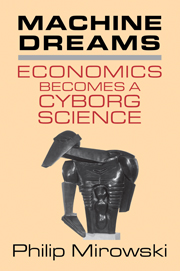Book contents
- Frontmatter
- Contents
- List of Figures and Tables
- Acknowledgments
- List of Abbreviations
- 1 Cyborg Agonistes
- 2 Some Cyborg Genealogies; or, How the Demon Got Its Bots
- 3 John von Neumann and the Cyborg Incursion into Economics
- 4 The Military, the Scientists, and the Revised Rules of the Game
- 5 Do Cyborgs Dream of Efficient Markets?
- 6 The Empire Strikes Back
- 7 Core Wars
- 8 Machines Who Think versus Machines That Sell
- Envoi
- References
- Index
2 - Some Cyborg Genealogies; or, How the Demon Got Its Bots
Published online by Cambridge University Press: 05 June 2012
- Frontmatter
- Contents
- List of Figures and Tables
- Acknowledgments
- List of Abbreviations
- 1 Cyborg Agonistes
- 2 Some Cyborg Genealogies; or, How the Demon Got Its Bots
- 3 John von Neumann and the Cyborg Incursion into Economics
- 4 The Military, the Scientists, and the Revised Rules of the Game
- 5 Do Cyborgs Dream of Efficient Markets?
- 6 The Empire Strikes Back
- 7 Core Wars
- 8 Machines Who Think versus Machines That Sell
- Envoi
- References
- Index
Summary
The human body is a machine which winds its own springs. It is the living image of perpetual motion.
Joseph la MettrieIn Gibbs' universe order is least probable, chaos most probable. But while the universe as a whole… tends to run down, there are local enclaves whose direction seems opposed…. Life finds its home in some of these enclaves. It is with this point of view at its core that the new science of Cybernetics began its development.
Norbert WienerA few years ago, the historian of science Adele Clark sought to see the world through a child's eyes and pose the question, “Mommy, where do cyborgs come from?” (in Gray, 1995, p. 139). As one often would when interrupted by a child's nagging questions, the overpowering temptation is to brush it off with a glib answer, perhaps something dismissive like: “Other cyborgs.” But if one instead begins to appreciate the responsibilities of parental obligation, the temptation shifts to a different plane, that of providing a nominally correct but semantically empty answer, perhaps something concerning the “enclaves” about which Wiener wrote. Those enclaves sound an awful lot like incubators: they are closed rooms where pressure and temperature are maintained at homeostatic levels conducive to embryonic life. Yet someone must be there to maintain that temperature and pressure; they had to convey the germs of life there from outside the closed room; and someone else had to install the boxes there in the first place. Genealogies are a tricky business, almost as tricky as life itself, frequently threatening to succumb to entropic degradation.
- Type
- Chapter
- Information
- Machine DreamsEconomics Becomes a Cyborg Science, pp. 26 - 93Publisher: Cambridge University PressPrint publication year: 2001



